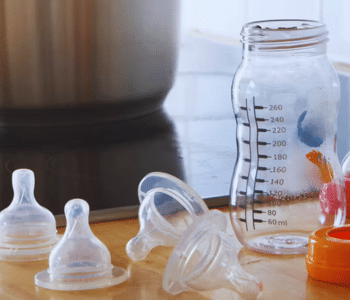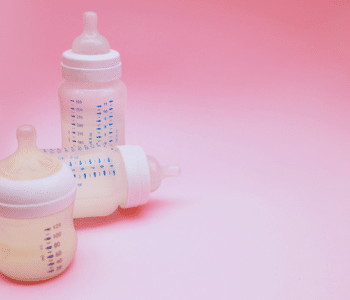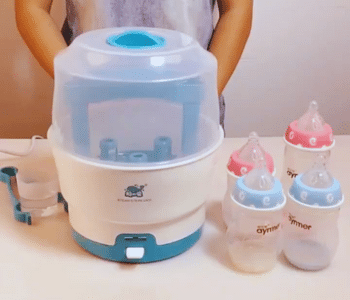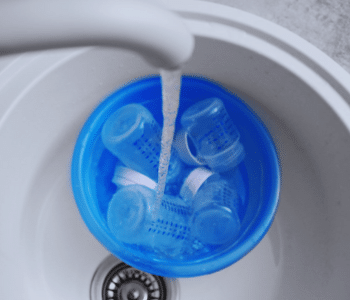When I was twenty-two years old, I wanted two things: 1. To be understood. 2. For people to think I was good at my job....Read more
There may be many bottles involved in newborn care. It’s common for new parents to ask! Whether washing their baby’s bottles and bottle parts in soap and water is adequate. Do specific circumstances need complete sterilization (which eradicates all germs)?
Sterilization isn’t required, as you may imagine, but this wasn’t always the case. Using clean equipment is crucial for your baby’s health when you bottle-feed. But it wasn’t always the case. Your baby’s bottles should be sterilized before being used for the first time. All baby feeding equipment should be sterilized. To help prevent the contamination of your baby’s milk with bacteria.

You only need to sanitize new bottles and nipples before the first use. Unless you reside in a region with well water or have a tainted city water supply. After the initial sterilization, a thorough wash in hot, soapy water is all that’s required. If the bottles and nipples are marked “dishwasher safe,” you can also put them in the dishwasher.
Apparatus For Sterilizing Baby Bottles
One quick and simple approach to make sure your baby’s feeding bottles are squeaky clean and free of germs and bacteria. It is to use an electric or steam sterilizer or sterilizing apparatus. Most diseases that a feeding bottle sterilizer and drier aid eradicate are foodborne illnesses. Diarrhea.
Babies are more prone to infection and illness than older children or adults because their immune systems have not yet fully matured. Use sterilizing equipment during feeding time to prevent the spread of harmful bacteria. It protects your baby’s sensitive digestive tract and immune system. Till your child is 12 months old, it’s crucial to sanitize all equipment, allowing them to progressively build up their immune.
As long as your baby is using a bottle, using a baby bottle sterilizer will continue to have many advantages. Bacteria won’t contaminate your child’s formula or breastmilk or buildup. Thanks to the milk bottle sterilizing tool.
Due to its rapid and convenient operation, a steam sterilizing machine or milk bottle sterilizer is a go-to choice for many parents. The most effective bottle sterilizers use only steam to kill up to 99.99% of bacteria instead of any chemicals, soaps, or other additives.
This organic cleaning technique is effective and secure. The majority of the top bottle sterilizers can do many tasks and automatically dry the contents inside. It can also be used to sterilize baby bottles, breast pump parts, toys, and pacifiers.
Benefits of sterilization
All germs, including bacterial endospores, are eliminated during sterilization. Instruments and other items that come into direct touch with the bloodstream should be sterilized.

Reducing the number of microorganisms to a point where there is no chance of infection transmission is the main goal of cleaning. Disinfection and sterilization. Depending on the design of the device, there is a possibility of infection transfer.
It’s crucial to sanitize bottles at least once when you initially buy them. Since you have no idea where the bottle was before it was packaged and delivered to you, preliminary sterilization is simple. Quick approach to guarantee the safety and health of the infant.
There are various situations in which sterilizing a baby’s bottle may be advised, including:
Suppose you are utilizing second-hand or borrowed bottles. Some mothers visit second-hand stores or ask a friend to lend them some baby bottles because of all the equipment and materials that newborns need. In these situations, it is essential to disinfect leftover bottles before introducing them to your child. The same holds true for bottles that have previously been used by your own older siblings.
If the infant is ill, the last thing you want to do is run the danger of reinfecting your baby by using dirty bottles. You want to keep them healthy at all times. Sterilizing the bottles will undoubtedly relieve your mind if you are worried about any germs or bacteria on them.
Suppose the infant is ill or was born prematurely. If a newborn is born prematurely or has a compromised immune system, sterilization is very crucial.
System for drying and sterilizing baby bottles.
1.In order to maintain your kid’s health and stop the growth of dangerous bacteria, baby bottles must be cleaned properly. Since milk remnants can serve as a haven for germs, proper cleaning should be a high priority.
2. Hand washing: Use warm, soapy water to clean bottles, nipples, and caps. Reach every region with a bottle brush, and then rinse with hot water to get rid of the soap residue. Until your infant is 12 months old, sterilize bottles.
3. Boiling Water: Boil bottles for at least five minutes in a kettle of water. This technique destroys bacteria, but make sure the bottles are heat-resistant and look for damage to the nipples.
4. Use microwave steam sterilizers by adhering to the manufacturer’s recommendations. These tools support maintaining bottle hygiene while being quick and easy.
5. UV Sterilizers: UV sterilizing equipment is gaining popularity. They destroy microorganisms using UV light. For proper use, adhere to the manufacturer’s instructions.
Remember that proper drying is essential regardless of the cleaning technique. Use a specialized drying rack or let all of the parts air dry on a clean, dry surface. Complete drying keeps the bottles clean and stops bacterial growth, making feeding time for your baby safe.
Using a decent drying rack for your baby’s bottles and other feeding supplies can be quite helpful. Air drying can work really well, but there is a knack to it. The first benefit of appropriate drying racks is that they make better use of counter space. This might not be obvious unless you use one and can compare it to drying bottles on a dish rack or a standard drainer.
Technique of sterilizing baby bottles
This will shield your child from illnesses, particularly those that cause vomiting and diarrhea.
You must use the following technique prior to sterilization:
As soon as possible after feedings, wash bottles, teats, and other feeding apparatus in hot, soapy water.
Cleaning bottles should only be done with a clean bottle brush. Cleaning the inside of teats should be done with a little brush. Teats can also be washed in hot, soapy water after being turned inside out. Salt should not be used to clean teats since it may be harmful to your infant.
Before sterilizing, thoroughly rinse all of your equipment under clean, cold running water.
If you’d like, you can clean the feeding supplies for your child in the dishwasher. Dishwasher cleaning does not sterilize the feeding apparatus, but it does clean it. Ensure that teats, lids, and bottles are pointing downward. To ensure they are totally clean, you might choose to hand wash teats individually.
Solution for sterilizing cold water
Observe the manufacturer’s guidelines.
• Let the sterilizing solution sit on the feeding equipment for at least 30 minutes.
• After every 24 hours, change the sterilizing solution.
When placing the bottles or teats in the sterilizing solution, make sure there are no air bubbles present. To keep all the equipment submerged in the solution, your sterilizer needs to have a floating lid or a plunger.
Steam sterilization (microwave or electric sterilizer)
Since there are several types of sterilizers, it’s crucial to adhere to the manufacturer’s instructions.
Boiling technique for sterilization
• Verify that boiling won’t damage the goods you intend to sterilize in this manner.
Set a timer so you don’t forget to turn off the heat and boil the feeding apparatus in a big pan of water for at least 10 minutes. Make sure that all stays below the surface.
• Keep in mind that using this method often results in rapid teat damage. Make sure teats and bottles are never torn, fractured, or otherwise harmed.
•It’s best to keep bottles and teats in the sterilizer or pan until you need them after you’ve completed sterilizing.
• Immediately attach the teats and lids to the bottles if you decide to remove them.
Hands should be washed and dried before touching sterile equipment. Use some sterilized tongs even better.
• Put the bottles together on a clean, disinfected surface or the sterilizer’s cover that has been turned up.
Baby bottle sterilizing device with integrated drying function
Dryers and Steam Sterilizers:
You can get an electric bottle sterilizer that automatically dries bottles with hot air, after using natural steam to eliminate 99.9% of germs. The process is really simple, thanks to these products.
Select this drying function as an integrated baby bottle sterilizing device. Considerable possibilities include automatic drying, which saves time and work. All along, it maintains the sterility of your infant goods.
Steriliser for baby bottles with automatic cutoff

For your medical facility, the Tuttnauer 2540M delivers steam sterilization. Instruments can be sterilized with the 2540M, whether they are wrapped or not. The Autoclave has a simple Plug’Play solution and is semi-automatic. Four standard strays and a sterilizing chamber measuring inches by 19 inches were included. The control panel on the Model is simple to operate. The 2540M autoclave will meet your sterilizing requirements. Without sacrificing quality, dependability, or safety.
- Automatic shutdown at the conclusion of the dry and sterilization processes.
- A durable electro-polished door and chamber.
- While the chamber is under pressure, a double safety locking feature stops the door from opening.
- The front of the device has a drain valve that makes it simple and quick to empty the water reservoir.
- In order to prevent overheating, a dual safety thermostat is used.
- Certificates from abroad
Sterilizer for baby bottles with a detachable tray
Natural Flow Deluxe Baby Bottle Sterilizer by Dr. Brown
Sterilize several infant bottles, accessories, pacifiers, and other items. This countertop baby bottle sterilizer is simple to use. and has baby bottle sterilizing equipment with cycle indications. There is a removable tray inside that is made to hold the bottles in the ideal position. An integrated accessory tray holds the parts, nipples, and pacifiers.
• You can set it and forget it thanks to auto shutdown.
- The bottles are placed properly on the removable tray thanks to the included measurement cup. and the built-in accessory tray holds the components, nipples, and pacifiers.
• After sterilization, use the included tongs to keep the bottles clean and your hands safe.
Current Research
According to CIRI research, the free resource offers a thorough. Evidence-based explanation of how microbes behave on hard surfaces. And the ensuing capacity to infect people. It was written by academic experts on CIRI’s Science Advisory Council.
The paper provides important research in support of the use. of sterilizing and disinfection to reduce viral transmission. Including information on microbe survivability. Typical modes of transmission, the impact of sterilizing and disinfection interventions. Paired prevention strategies and cleaning and disinfection frequency recommendations.
Is sterilizing infant bottles necessary?
It’s crucial to sanitize bottles at least once when you initially buy them. After that, sterilizing bottles and their attachments is no longer required. Baby products once required sterilizing because water supplies weren’t always clean. But happily, this isn’t a problem anymore.
How are baby bottles sterilized at home?
Split apart. Separate every component of a bottle, including the bottles, nipples, caps, rings, and valves.
Rinse. Holding the bottle components and any other feeding supplies under flowing water will rinse them. It might be either warm or cold water.
Wash. Dishwasher: Dispose of bottle pieces and other feeding supplies. To prevent small things from getting stuck in the dishwasher filter, place them in a closed-top basket or mesh laundry bag. To help kill more germs, run the dishwasher with hot water and a heated drying cycle (or sanitizing mode).
Take out of the dishwasher. Before removing and storing cleaned goods, wash your hands thoroughly with soap and water.
If goods need more time to dry entirely, lay them out on a clean, unused dish towel or paper towel. Let them air dry completely before putting them somewhere dust- and dirt-free. Avoid rubbing or patting items dry with a dish towel, as doing so could spread germs.
Is boiling or sterilizing baby bottles preferable?
An extra step called sterilization can help kill more germs than regular cleaning. It offers anti-germ defense, but healthy infants with access to clean water and robust immune systems do not need it. In spite of this, the Centers for Disease Control and Prevention recommends. Sanitizing feeding supplies at least once each day.
Boiling water, microwaveable bottle sterilizers. Electric steam sterilizers are just a few of the suggested methods for sterilizing bottles. The one is not always better than the other. Electric steamers operate by using steam and high temperatures to destroy germs, and they plug into outlets.
Similar to boiling water, sterilizing kills microorganisms by boosting temperatures. On the market, a variety of sterilizers, including microwave-friendly sterilizers, are available. The secret is to adhere to the manufacturer’s directions. Before starting the steam or sterilizing procedure, make sure bottles, nipples, and caps have been cleaned.
Besides heated steam to destroy germs, microwave sterilizers also kill bacteria. The sterilizer has water, which is then microwaved for a while. Compared to an electric steamer, this approach takes less time.
Final thoughts
Help stop germs from contaminating the milk you give your baby. I hope you were able to find answers to the most often-asked questions on sterilizing. Follow the cleaning instructions your healthcare practitioner provides for baby feeding equipment especially if your child is hospitalized.

Each time a child is fed, the bottle should be cleaned. Throw away any unfinished formula if your infant doesn’t finish a bottle within two hours. Suppose the formula or breast milk is added to a partially used bottle. Or if a used bottle is just washed rather than thoroughly cleansed, germs can quickly proliferate.

When I was twenty-two years old, I wanted two things: 1. To be understood. 2. For people to think I was good at my job. As a first time founder, I remember feeling under-qualified. I felt like an impostor—and it showed. I struggled to communicate my value in a way that my colleagues and potential investors could understand. I realized I needed to clarify my message and use social media as a tool to help me build my personal brand. This would help me look more credible, I thought. So I got to work. I updated my social media profiles, built a personal website, and began sharing my story online. The more content I shared, the more confident I became. And the more confident I became, the more credible I appeared. Now i am writing blogs for madeforkids.co.uk on different topics on kids.
- Latest Posts by Anna Vatuone
-
What Are The Uses Of A Drone
- -
What Are The Uses Of Playhouse
- -
How To Get A Child To Warm Up To You
- All Posts
